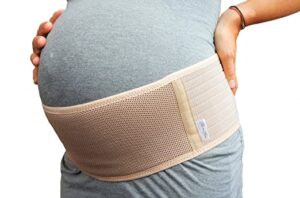Synthesis Pubis Dysfunction (SPD) is the increased movement at the pubic joint which is usually associated with pain centrally and into the groin, on one or both sides, SPD is also linked to Pelvic Girdle Pain (PGP).
Symptoms:
-
Pain over the pubic bone at the front, between your legs.
-
Pain can also be into your lower back (see also Pelvic Girdle Pain).
-
Pain can be in the area between your vagina and anus (perineum) see also section on Perineum pain.
-
The pain can spread into one or both thighs.
-
You may notice pain when walking or going up or down stairs.
-
Pain when standing on 1 leg (for example, when you’re getting dressed).
-
Pain when turning over in bed or moving your legs apart (for example, when you get out of a car).
Causes:
-
Changes in hormones.
-
A history of previous low-back and pelvic girdle pain.
-
Previous trauma to the pelvis region.
-
If you have had more than one pregnancy then you are more likely to suffer with SPD / PGP (Pelvic Girdle Pain).
-
If you carry out a manual-type job with repetitive / awkward lifting positions.
-
You are also more likely to suffer with pelvic related pain if you have an increased body BMI prior to and and/or by the end of pregnancy.
-
If you have increased mobility of other joints in the body, this may leave you more susceptible to pelvic related pain (either at the pubic or other pelvic joints).
Here is what the evidence says about the treatment options:
Pilates – evidence does support the use of Pilates-based exercise during pregnancy for the treatment of many conditions, including pelvic related pains. Evidence has also shown that Pilates can also have a positive effect on the birth and the outcome following the birth.
Have a look at our Top 5 online Pilates programmes here.
Yoga – evidence suggests that prenatal yoga may help reduce pelvic pain and help to improve mental conditions like stress, depression, anxiety that can be associated with pain in pregnancy. Yoga has also been shown to help with pain and pleasure at the delivery of the baby and with perinatal outcomes such as lower delivery times and obstetrical complications.
There are lots of Online Yoga programmes available, have a look at our Top 5 here (and why we love them)! You can also read our blog on how yoga can help in other ways.

Aquatic Exercise – If you are struggling to exercise due to pain or looking for ways to keep fit and are worried about causing pain then swimming (or any other form of aquatic exercise) have been shown to be really beneficial for pelvic related pains like SPD. Have a look at all the benefits shown in THIS study.

TENS – evidence is in favour of the use of TENS. THIS study concluded that treating pelvic related pains with acupuncture or TENS resulted in maintenance of functioning and physical activity and also less pain and concern about pain. Either intervention could be recommended as a non-pharmacological alternative for pain relief and may enable pregnant women to stay active. Always speak to your midwife or GP before using a TENS machine to check it is the right course of action for you (and your baby). TENS is generally not recommended in the first trimester of pregnancy.
There are many different TENS machines available to buy, so if you are thinking of TENS as a treatment option then have a look at our Top 5 picks to make things a little easier.
Pregnancy Support Belt – evidence is available for the use of support belts for SPD and other pelvic pains. THIS study concluded that wearing a support belt during pregnancy can have beneficial effects such as; reduced lower back pain, pelvic girdle pain and SIJ pain, improvement of functionality and mobility and reduction of risk of fall during pregnancy. THIS study showed that Pelvic Support belts were a great option in the short term when compared to exercises.
There are currently no studies to show which support belts work best or for how long you should be wearing them, so we have put together our top 5 choices (here) to help guide you based on what they can help with and what we like about them.
Pregnancy support Pillow – There is little evidence in support of the pregnancy pillow. That’s not to say that it doesn’t work / help, it just means that there hasn’t been a need to carry out studies on them. A pregnancy pillow aims to help keep your spine and hips in a neutral position whilst lying on your side. I know from personal experience that they are very comfortable and can double up as a feeding pillow once the baby is born, I think they’re a good investment but whether they will help to alleviate SPD / groin pain – the jury is still out on that one.
Have a look at out Top 5 pregnancy pillows available here.
In addition to the above treatments, the POGP (Pelvic, Obstetric and Gynaecological Physiotherapy Association) suggest that you also try to avoid:
- Standing on 1 leg
- Bending and twisting to lift, or carrying a baby on 1 hip
- Crossing your legs
- Sitting on the floor, or sitting twisted
- Sitting or standing for long periods
- Lifting heavy weights, such as shopping bags, wet washing or a toddler
- Vacuuming
- Pushing heavy objects, such as a supermarket trolley
- Carrying anything in only 1 hand (try using a small backpack)
What symptoms to watch out for:
If you have any of the following symptoms then go to your nearest accident and emergency department immediately:
-
Severe low back pain.
-
Pain, numbness, or weakness in one or both legs that causes you to stumble or have trouble getting up from a chair.
-
Loss of or altered sensations in your legs, buttocks, inner thighs, feet or areas that you sit on when in a chair (including genitals / anus) that is severe or gets worse and worse.
-
Recent problem with bladder or bowel function, such as trouble eliminating urine or waste (retention) or trouble holding it (incontinence).
-
Sexual dysfunction that has come on suddenly.




